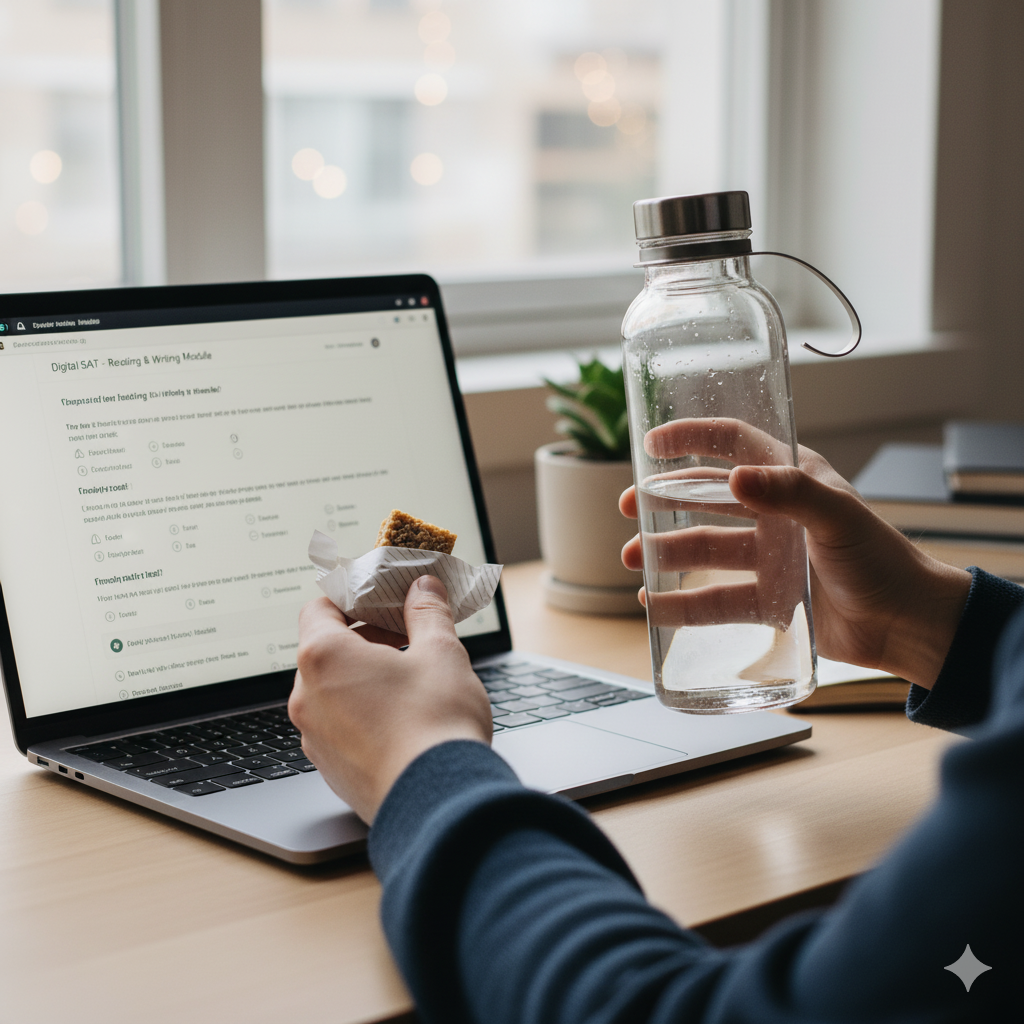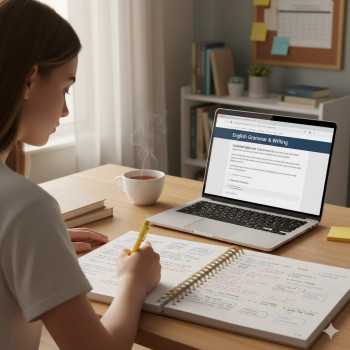Pause to Power Up: Why Breaks Matter More Than You Think
If you’ve ever pushed through the last 20 minutes of a practice SAT section while your eyes blurred and your brain felt like a wet sponge, you already know the truth: endurance and attention are not the same thing. The Digital SAT is shorter and different from the paper test in some ways, but it still asks for sustained, high-quality focus. Breaks aren’t a sign of weakness or procrastination—they’re a strategic tool. Used well, they recharge attention, improve accuracy, and help you learn more from each practice test.
What Happens in Your Brain During a Practice Test
Think of focus as a resource that gets used continuously. During a practice test, your brain pulls from that resource to read dense passages, decode tricky math problems, and juggle timing. Two things happen over time: cognitive fatigue (mental tiredness) grows, and the ability to manage attention—especially sustained, directed attention—declines.
Short pauses let the brain shift from intense task mode toward recovery. During a break, your mind can do two helpful things: consolidate what you just practiced and reduce stress hormones that interfere with reasoning. That’s why a 5–10 minute break after a demanding section often returns you to the test with higher accuracy and clearer decision-making.
Short Breaks vs. Long Breaks: When to Use Each
- Micro-breaks (30–60 seconds): Quick eye rests, deep breaths, or standing up to stretch. These are ideal between blocks of intense focus and help reduce physical strain.
- Short breaks (5–10 minutes): The sweet spot for most students during practice tests. Enough time to step away mentally and physically without losing momentum.
- Long breaks (15–30+ minutes): Use for full mental resets: after a full practice test or when switching study modes (e.g., from full test-taking to review and reflection).
How to Structure Breaks During Digital SAT Practice Tests
The Digital SAT (practiced via Bluebook for official practice) is adaptive and timed differently than older paper formats, but the idea of section-focused practice remains. A thoughtful break schedule should reflect both the natural structure of the test and your personal attention rhythms.
Practical Break Plan for a Full-Length Practice Test
Below is a sample structure that balances realism (simulating test stamina) with smart recovery moments so you can practice at high quality.
| Segment | Duration | What to Do | Why It Helps |
|---|---|---|---|
| Reading & Writing Section | ~65 minutes | Tackle passages; flag hard questions for later. Micro-breaks recommended between long passages. | Maintains reading accuracy and prevents mental drag. |
| Short Break | 5–8 minutes | Stand, walk, hydrate, snack light (fruit/nuts), practice breathing. | Restores clarity and reduces decision fatigue. |
| Math Section (No-Calculator & Calculator) | ~80–90 minutes total | Alternate problem pace: start with easier or familiar problems to build momentum. | Prevents early burnout from difficult multi-step problems. |
| Recovery Break | 8–12 minutes | Short walk outside if possible; light stretching; brief reflection. | Full reset before review or next practice iterations. |
Why This Schedule Works
- It mimics the cognitive rhythm of intensive reading then problem-solving.
- Short, consistent rests prevent attention collapse in the final minutes of a section.
- Recovery breaks allow consolidation—your brain literally files away the strategies you used and the mistakes you made, making the next practice more instructive.
Active vs. Passive Breaks: What Science and Experience Recommend
Breaks come in two flavors: passive (scrolling social media, zoning out) and active (light exercise, deliberate rest). While passive breaks can feel relaxing, they’re often less restorative. Active breaks—especially brief movement, hydration, or breathing—bring oxygen to your brain and reset your focus faster.
Good Break Activities
- 5–10 minutes of walking or gentle stretching
- Deep-breathing exercises or box breathing (2–3 minutes)
- Refueling with a small, balanced snack: banana, nuts, yogurt
- Quick review of one or two flagged questions to plant a seed of strategy
Poor Break Activities
- Scrolling social media for long periods (fragmented attention)
- Watching emotionally intense videos that spike arousal
- Beginning a new, time-consuming project or chore
How Breaks Improve Learning from Practice Tests
Beyond refreshing attention, breaks change how you learn. A well-timed break inserted between a practice block and a review session increases the retention of strategies and reduces the likelihood of repeating the same mistakes in the next run.
After a break, the brain enters a better state for meta-cognition—thinking about your thinking. That means your review (what questions you missed, why you missed them, what strategies worked) becomes higher quality, which directly improves future practice efficiency.
Example: Two Students, Two Approaches
- Lena, no breaks: Completes two practice sections back-to-back. She finishes faster but feels exhausted and later repeats the same careless errors during review.
- Marcus, structured breaks: Takes a 7-minute active break between sections. He returns calmer, identifies root causes of errors, and adapts strategy for the next section—improving accuracy.
How Long Should You Practice Before a Break?
There’s no single truth for everyone—personal energy patterns matter. But a reliable rule of thumb for SAT practice is: work in focused blocks of 25–50 minutes with short breaks in between. If you’re doing heavy reading or prolonged concentration, lean toward shorter blocks (25–35 minutes). For mixed problem-solving or strategy practice, a 45–50 minute block can be productive.
Pomodoro-Style Examples for SAT Prep
- 25/5 Pomodoro: 25 minutes work, 5 minutes break. Great for question-level intensive drills and reviewing explanations.
- 45/10 Balanced Block: 45 minutes work, 10 minutes break. Closer to the actual mental conditions of longer SAT sections.
- 90/15 Endurance Block: 90 minutes work, 15 minutes break. Use sparingly to build test-day stamina (simulate full-section conditions).
Micro-Practices During Breaks That Yield Big Gains
Not all break time must be idle. A brief, targeted mental action can multiply the benefits of a short pause. Here are a few power moves you can fit into a 5–8 minute break:
- Write one sentence about a mistake you made and what you’d do differently next time.
- Do a two-minute breathing reset to lower anxiety and improve clarity.
- Hydrate and have a 50–100 calorie snack that combines carbs and protein for steady blood sugar.
- Stand and move for 60–90 seconds to restore circulation and focus.
Beyond Breaks: Building Stamina Over Weeks
Breaks are one tool in the toolbox. Stamina is built gradually. If your practice sessions leave you exhausted or unfocused, try a tiered approach to training:
- Week 1–2: Short blocks (25–35 minutes) with frequent breaks — build consistent accuracy.
- Week 3–4: Longer blocks (45–50 minutes) with deliberate short breaks — practice pacing and strategy under closer-to-test conditions.
- Week 5+: Full-section simulations and recovery routines — build mental endurance and habit consistency.
It’s like training for a sport: you don’t run a marathon on day one. You increase volume, rest properly, and adapt.
What to Track: Metrics That Tell You If Breaks Are Working
Breaks feel good, but how do you quantify improvement? Track a few simple metrics across practice tests to see the impact of better break habits:
| Metric | Why It Matters | How to Measure |
|---|---|---|
| Accuracy by Question Order | Shows whether you’re burning out late in sections. | Record correct/incorrect in early, mid, late groups for each section. |
| Time Spent Per Question | Reveals pacing issues and decision fatigue. | Use the practice app timer or note averages for problem types. |
| Subjective Focus Rating | Captures how alert and engaged you felt. | Rate 1–5 after each block; look for upward trends. |
| Review Quality | Better breaks should lead to more insightful reviews and fewer repeat mistakes. | Count repeat mistakes week-to-week. |
Common Pitfalls and How to Avoid Them
Students often sabotage good break protocols without realizing it. Here are common traps and how to sidestep them:
- Trap: Using social media during breaks. Fix: Keep your phone in another room or set a strict 3–5 minute tech-free window for recovery.
- Trap: Over-snacking on sugary foods that cause energy spikes and crashes. Fix: Choose balanced small snacks (nuts, fruit, yogurt).
- Trap: Skipping breaks to “save time.” Fix: Remember that rushed practice often cements bad habits; a focused 10-minute break yields longer-term efficiency.

How Personalized Tutoring Enhances Break Strategy
Not every student benefits from the same break pattern. Personalized tutoring helps by tailoring break and practice schedules to your unique rhythms. For example, Sparkl’s personalized tutoring blends 1-on-1 guidance, tailored study plans, and data-driven insights to shape break timing, active-break activities, and pacing strategies that fit your natural focus cycles. A tutor can observe when your accuracy drops, recommend specific break lengths, and hold you accountable to the routine so it becomes a habit.
How a Tutor Brings This to Life
- Expert tutors identify when you’re losing accuracy and suggest micro-adjustments to break timing.
- They can design study blocks aligned with your daily energy patterns—morning vs. afternoon learners need different rhythms.
- With AI-driven insights, tutors can analyze practice-test data to refine frequency and type of breaks, making each practice session intentionally better.
Test-Day Translation: Using Breaks Without Overdoing It
Simulating test-day conditions in practice is important—but so is learning how to use the breaks the test allows. On test day, the digital platform has scheduled breaks; you can also take unscheduled breaks under certain conditions when practicing in Bluebook for preparation. The goal on test day is to use break time as a reset, not a distraction. Plan brief, predictable actions for those minutes: hydrate, a quick stretch, a breathing reset, and a strategic thought about pacing for the next section.
Quick Test-Day Break Routine
- Stand and stretch for 60–90 seconds.
- Take three deep breaths (inhale 4s, hold 4s, exhale 6s).
- Sip water; avoid heavy snacks right before resuming.
- Spend 30 seconds reviewing your pacing plan for the next section (e.g., “Two minutes early to check flagged items”).
Putting It Into Practice: A Two-Week Break-Focused Plan
Here’s a practical two-week mini-program you can use to test and adapt break strategies. Use a journal or spreadsheet to track the metrics above.
- Days 1–3: Try 25/5 blocks while doing mixed practice questions. Note focus ratings and errors.
- Days 4–7: Shift to 45/10 blocks for full-section practice. Use active breaks; track accuracy drops by question order.
- Days 8–10: Simulate full-length practice with scheduled recovery breaks. Note stamina and repeat mistakes.
- Days 11–14: Adjust based on your data: lengthen or shorten breaks, change break activities, and if possible, consult a tutor for targeted refinement.
Final Thoughts: Make Breaks Work for You
Breaks are more than pauses; they’re a strategic edge. When you practice with intention and use recovery strategically, you’ll find that you make fewer careless errors, learn from mistakes faster, and build the stamina to perform at your best on test day. Keep experimenting gently—track, tweak, and build routines that map to your real-life energy patterns.
And remember: if you want a hands-on partner to design the right practice-plus-break plan—one that combines 1-on-1 tutoring, tailored study plans, and data-driven adjustments—personalized programs like Sparkl’s can help you turn good intentions into consistent, measurable gains. With the right guidance, smart breaks become part of a bigger, smarter study system that helps you reach your score goals without burning out.
Quick Checklist Before Your Next Practice Test
- Pick a break schedule and stick to it for at least three sessions.
- Plan active break activities and keep snacks simple and balanced.
- Track simple metrics (accuracy, time per question, focus rating).
- Adjust based on data and, if possible, get targeted feedback from a tutor.
- Practice the test-day break routine until it feels automatic.
Practice well, pause strategically, and watch your focus—and your scores—improve. You’re training both skill and stamina. Treat breaks as part of the work, not an escape from it, and you’ll get more from every minute you spend preparing for the Digital SAT.














No Comments
Leave a comment Cancel